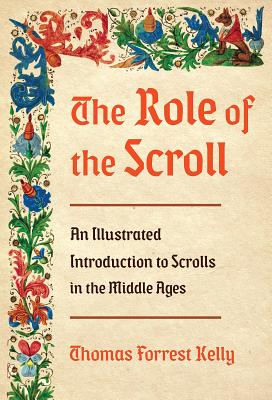
The Role of the Scroll: An Illustrated Introduction to Scrolls in the Middle Ages
Description
A beautifully illustrated, full-color guide to scrolls and their uses in medieval life.
Scrolls have always been shrouded by a kind of aura, a quality of somehow standing outside of time. They hold our attention with their age, beauty, and perplexing format. Beginning in the fourth century, the codex—or book—became the preferred medium for long texts. Why, then, did some people in the Middle Ages continue to make scrolls?
In The Role of the Scroll, music professor and historian Thomas Forrest Kelly brings to life the most interesting scrolls in medieval history, placing them in the context of those who made, commissioned, and used them, and reveals their remarkably varied uses. Scrolls were the best way to keep ever-expanding lists, for example, those of debtors, knights, and the dead, the names of whom were added to existing rolls of parchment through the process of “enrollment.” While useful for keeping public records, scrolls could also be extremely private. Forgetful stage performers relied on them to recall their lines—indeed, “role” comes from the French word for scroll—and those looking for luck carried either blessings or magic spells, depending on their personal beliefs. Finally, scrolls could convey ceremonial importance, a purpose that lives on with academic diplomas.
In these colorful pages, Kelly explores the scroll’s incredible diversity and invites us to examine showy court documents for empresses and tiny amulets for pregnant women. A recipe for turning everyday metal into gold offers a glimpse into medieval alchemy, and a log of gifts for Queen Elizabeth I showcases royal flattery and patronage. Climb William the Conqueror’s family tree and take a journey to the Holy Land using a pilgrimage map marked with such obligatory destinations as Jaffa, where Peter resurrected Tabitha, and Ramada, the city of Saint Joseph’s birth. A lively and accessible guide, The Role of the Scroll is essential reading—and viewing—for anyone interested in how people keep record of life through the ages.
Praise for The Role of the Scroll: An Illustrated Introduction to Scrolls in the Middle Ages
We all supposed that scrolls had more or less died out in the ancient world, to be superseded by the codex. This fascinating book unfolds a parallel universe of manuscripts throughout the Middle Ages. The living fossils from antiquity were actually still there, alive and invisible, in every aspect of medieval book production. They just keep rolling, they keep on rolling along.
— Christopher de Hamel, author of Meetings with Remarkable Manuscripts
A fascinating and scientifically sound study that will be highly appreciated by a wider audience of students and medieval manuscript lovers.
— Giulia Orofino, professor of art history, University of Cassino
There is much to admire in Kelly’s concise, well-illustrated, and vivid account.
— Bernard Meehan, research fellow, Trinity Medieval History Research Centre, Trinity College Dublin
An astonishingly clear and interesting survey of how we used to read and how we read today…a gem of scholarship and of great interest to anyone, and will be the definite work for this dominant medium of reading for years to come.
— Michael Scott Cuthbert, associate professor of music and faculty director of digital humanities, MIT
In this beautifully and copiously illustrated volume, readers will be introduced to medieval scrolls magical and medical, genealogical and historical, alchemical and astronomical. An important contribution to the history of the book and will be a delightful read for any—pardon the misnomer—bibliophile.
— Lisa Fagin Davis, author of La Chronique Anonyme Universelle
This handsomely illustrated and lucid study surveys the scroll across centuries and cultures. Fascinating discoveries await the reader on virtually every page. A delight to the eye as much as to the mind.
— Joseph Dyer, associate professor emeritus, University of Massachusetts, Boston
This is a wonderful introduction to the medieval scroll. A thoroughly enjoyable reading with numerous insights on this very popular form and exceptionally illustrated with key examples and explanatory caption.
— Orietta Da Rold, fellow at St. John’s College, Cambridge
